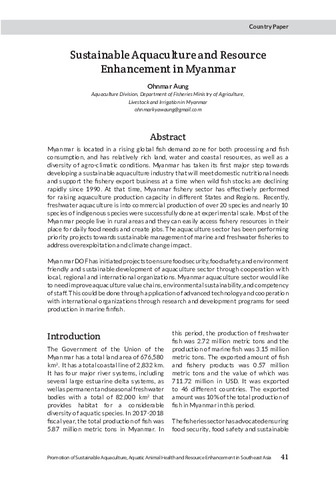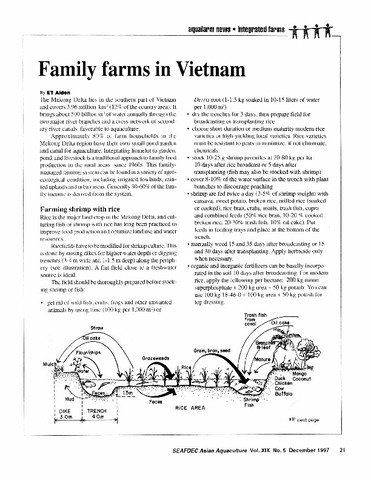Sustainable aquaculture and resource enhancement in Myanmar
- Global styles
- MLA
- Vancouver
- Elsevier - Harvard
- APA
- Help

วันที่
2021-12ผู้เขียน
Page views
1,057ASFA keyword
AGROVOC keyword
เมตาดาต้า
แสดงระเบียนรายการเต็ม
Share
นามธรรม
Myanmar is located in a rising global fish demand zone for both processing and fish consumption, and has relatively rich land, water and coastal resources, as well as a diversity of agro-climatic conditions. Myanmar has taken its first major step towards developing a sustainable aquaculture industry that will meet domestic nutritional needs and support the fishery export business at a time when wild fish stocks are declining rapidly since 1990. At that time, Myanmar fishery sector has effectively performed for raising aquaculture production capacity in different States and Regions. Recently, freshwater aquaculture is into commercial production of over 20 species and nearly 10 species of indigenous species were successfully done at experimental scale. Most of the Myanmar people live in rural areas and they can easily access fishery resources in their place for daily food needs and create jobs. The aquaculture sector has been performing priority projects towards sustainable management of marine and freshwater fisheries to address overexploitation and climate change impact.
Myanmar DOF has initiated projects to ensure food security, food safety, and environment friendly and sustainable development of aquaculture sector through cooperation with local, regional and international organizations. Myanmar aquaculture sector would like to need improve aquaculture value chains, environmental sustainability, and competency of staff. This could be done through application of advanced technology and cooperation with international organizations through research and development programs for seed production in marine finfish.
การอ้างอิง
Aung, O. (2021). Sustainable aquaculture and resource enhancement in Myanmar. In F. A. Aya, L. D. de la Peña, N. D. Salayo, & E. A. Tendencia (Eds.), Proceedings of the International Workshop on the Promotion of Sustainable Aquaculture, Aquatic Animal Health, and Resource Enhancement in Southeast Asia (pp. 41–45). Tigbauan, Iloilo, Philippines: Aquaculture Department, Southeast Asian Fisheries Development Center.
Type
Conference paperISBN
9789719931102 (Print); 9789719931119 (PDF)
Except where otherwise noted, this item's license is described as Attribution-NonCommercial-ShareAlike 3.0 IGO
Related items
Showing items related by title, author, creator and subject.
-
The Philippine aquaculture industry
Camacho, Arsenio S.; Macalincag-Lagua, Natividad (Aquaculture Department, Southeast Asian Fisheries Development Center, 1988)The aquaculture sector of the Philippine fishing industry registered the highest growth rate of 12.5% in 1977-1986. The contribution of aquaculture to the total fish production was equivalent to 24% in 1986 compared to ... -
Family farms in Vietnam
Aldon, Eva T. (Aquaculture Department, Southeast Asian Fisheries Development Center, 1997) -
Nursery and grow-out operation and management of Penaeus monodon (Fabricius)
Corre, Kaylin G. (Aquaculture Department, Southeast Asian Fisheries Development Center, 1988)The results of research on nursery and grow-out rearing of prawn conducted by the SEAFDEC Aquaculture Department for over a decade are reviewed. Different rearing facilities designed to accommodate hatchery-produced prawn ...






